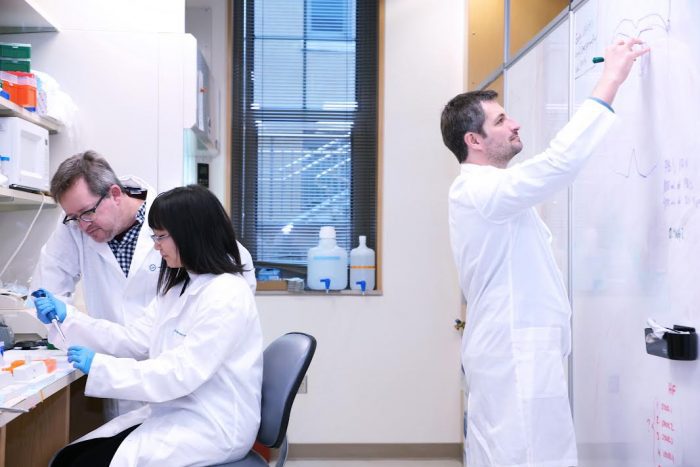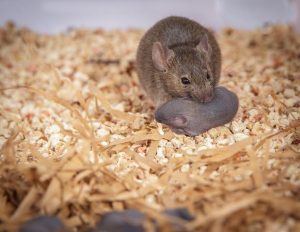CSHL’s Shea studies blue spot for clues about maternal behavior

By Daniel Dunaief
The black box has a blue spot.
Often considered so mysterious that it has been called “the black box,” the brain has a small cluster of cells called the locus coeruleus (LC), or blue spot because it appears blue.
The LC is the predominant source of the neurotransmitter noradrenaline, which plays numerous roles, including triggering the “fight or flight” response, sleep/wake regulation and memory.
Recently, Cold Spring Harbor Laboratory Associate Professor Stephen Shea and his post doctoral researcher Roman Dvorkin demonstrated that the LC was involved in normal maternal social behavior. In the publication Journal of Neuroscience, they demonstrated that surrogate mothers had a spike in this neurotransmitter just at the time when they retrieved young pups that had rolled out of the nest.
“Most of the research on noradrenaline and the LC has been involved in non-social behavior,” said Shea. Researchers have recorded it extensively during “cognitive tasks and memory formation.”
The evidence for its involvement in social behaviors has been more indirect. With the exception of a study 35 years ago that made a few recordings in cats, the current research is the “first time anyone has recorded” the LC during a more normal social behavior, Shea said.
Research on this blue spot could prove valuable in connection with understanding and treating a wide range of diseases and disorders. Noradrenaline (NA) is “one of the systems that is disturbed in anxiety and depression,” Dvorkin said. It also may be involved in other diseases, like autism. Scientists have conducted research on the LC and ADHD, Parkinson’s disease and Alzheimer’s disease, Dvorkin explained.
Some studies have also linked Rett syndrome, for example, which is a rare inherited genetic disorder that affects mostly girls and can alter the ability to speak, walk and eat, to lower levels of noradrenaline.
“There’s evidence that the LC has pathology in Mecp2 mice,” said Shea, referring to a gene traced to Rett. “We are working on that directly.”
Researchers believe studying the structure of the LC could lead to diagnostics and therapeutics for some of these diseases. Dvorkin suggested that this kind of research is “important to see how it works under normal, awake conditions.”
Monitoring the release of this neurotransmitter during a typical social behavior among female mice provides a context-connected understanding of its potential role.
“When people are studying this, they often use investigator-contrived tasks,” Shea said. “This is the system that preexisted for mice to use for other purposes.”
Shea has done earlier work with the LC, particularly as the sense of smell is so prominent in social interactions for mice. He demonstrated that anesthetized mice exposed to the scent of an unfamiliar mouse react as if they have a familiarity with the mouse.
She believes the LC initiates sensory plasticity or sensory learning. NA can affect the sensory responses in parts of the brain that carry information, creating a stored memory. While his extensive work offers some clues about the role of the LC in mice, all vertebrates have the LC in their brain stems, including humans.
Shea said other research has demonstrated the involvement of the LC in cognitive tasks and memory formation, including during periods of sleep and wakefulness.
Blocking the release of noradrenaline is challenging in part because it is compact and the cells in the brain interact with so many of their neighbors, which makes turning on or off a specific signal from one region especially challenging.
At the University of Washington, Richard D. Palmiter and S.A. Thomas published a visible and definitive paper in 1997 in the journal Cell that brought the LC to other researcher’s attention.
These researchers created complete knockout mice, where they found that rodents lacking noradrenaline were “really bad mothers,” according to Shea.
In their research, Dvorkin and Shea used optogenetics and chemogenetics to inactivate the LC and the release of noradrenaline.
Future experiments

The next step in this research could involve understanding the relative importance of the signal from the LC and noradrenaline.
In typical life settings, mice and other vertebrates confront competing signals, in which a pup rolls out of the nest at the same time that one of their many predators, like a hawk or other bird is circling overhead.
“That could be a next step” in this research, said Dvorkin.
Dvorkin believes it is possible to increase or decrease the threat level for mice gradually, in part because mice learn quickly when the threat is not real or what to avoid if the threat is too risky.
Shea is also looking more closely at courtship behavior.
The LC could be involved in sexual selection and in dominance hierarchies, enhancing the aggressive behavior of alpha males towards less dominant males.
“We see big signals associated with events in courtship, including when the female and male begin to mate,” said Shea.
A resident of East Northport, Dvorkin lives with his wife Paolina and their nine year-old son Adam, who is in third grade at Pulaski Road School.
Originally from Afula in northern Israel, Dvorkin has been working in Shea’s lab for over five years. Outside the lab, he enjoys spending time with his family, taking pictures, and swimming at the JCC.
Dvorkin has enjoyed his work at CSHL, which he described as a “great experience in a beautiful place,” where he can appreciate the quiet and where he has received considerable support.
In the future, he’d like to apply his expertise in working on neuronal cell cultures and behaving animals to address translative questions, such as neurodegeneration.






